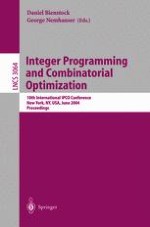2004 | Buch
Integer Programming and Combinatorial Optimization
10th International IPCO Conference, New York, NY, USA, June 7-11, 2004. Proceedings
herausgegeben von: Daniel Bienstock, George Nemhauser
Verlag: Springer Berlin Heidelberg
Buchreihe : Lecture Notes in Computer Science
Enthalten in: Professional Book Archive
